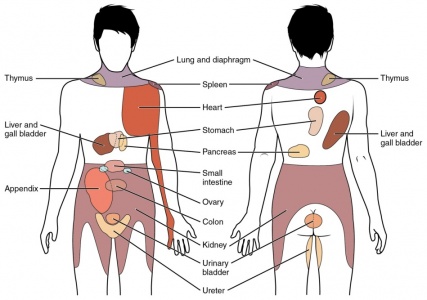Spinal Masqueraders: Difference between revisions
(Created page with "== Red Herrings == Red Herrings are “any misleading biomedical or psychosocial factors that will deflect the course of accurate clinical reasoning”<ref name="G+S2009" />.Wh...") |
No edit summary |
||
| Line 1: | Line 1: | ||
== Introduction == | |||
Spinal masqueraders are conditions which present as lower back pain but are actually caused by non-mechanical referred pain from a visceral structure. Patients will present with lower back pain but the source is not a mechanical structure<ref name="Walcott">Walcott B, Coumans J, Kahle K. Diagnostic pitfalls in spine surgery: masqueraders of surgical spine disease. Neurosurgical Focus. 2011;31(4).</ref>. Although the percentage of patients seen by Physiotherapists with these conditions is small it is important to be able to recognise the red flags that could point towards these conditions. | |||
==Sources of Visceral Pain== | |||
== | |||
Some of the sources of visceral pain include: | Some of the sources of visceral pain include: | ||
| Line 25: | Line 14: | ||
The blood supply to internal organs is in close proximity to the sympathetic nerve system so changes to the blood supply from ischemia, distention of inflammation can directly affect the nerve innervation<ref name="Eveleigh" />. | The blood supply to internal organs is in close proximity to the sympathetic nerve system so changes to the blood supply from ischemia, distention of inflammation can directly affect the nerve innervation<ref name="Eveleigh" />. | ||
This diagram depicts the most | ==Referral Patterns for visceral pathologies== | ||
This diagram depicts the most common referral patterns for visceral pathologies. | |||
[[Image:Visceral pain referral.jpg|427x300px]] | [[Image:Visceral pain referral.jpg|427x300px]] | ||
Revision as of 12:57, 11 October 2015
Introduction[edit | edit source]
Spinal masqueraders are conditions which present as lower back pain but are actually caused by non-mechanical referred pain from a visceral structure. Patients will present with lower back pain but the source is not a mechanical structure[1]. Although the percentage of patients seen by Physiotherapists with these conditions is small it is important to be able to recognise the red flags that could point towards these conditions.
Sources of Visceral Pain[edit | edit source]
Some of the sources of visceral pain include:
- Inflammation - eg. Appendicitis
- Distention - eg. Bowel Obstruction
- Ischemia - eg. a tumour blocking blood supply
The blood supply to internal organs is in close proximity to the sympathetic nerve system so changes to the blood supply from ischemia, distention of inflammation can directly affect the nerve innervation[2].
Referral Patterns for visceral pathologies[edit | edit source]
This diagram depicts the most common referral patterns for visceral pathologies.
Klineberg et al (2007) summarised examples of medical causes of back pain, and the symptoms often associated with them:
| Aortic Aneurysm | Back pain that is acute, severe and tearing. It is a true medical emergency. Pain can radiate to the anterior chest. Rest does not relieve it. Palpation over the back and changes in position do not aggravate the pain. Palpation of the abdomen may increase pain. Loss of lower extremity pulses may occur as the dissection progresses. |
| Myocardial Infarction | Back pain is usually mid thoracic and may radiate to the arm or axilla. Typical symptoms being: Anterior chest heaviness Crushing chest pain Diaphoresis (excessive sweating) Sense of impending doom Pain radiating to the shoulder, neck, arm(s). Pain may be unaffected by posture or changes in position. |
| Ectopic Pregnancy | Classic triad of symptoms: Missed menstrual period Vaginal bleeding Abdominal or lower back pain. Patients may also be diaphoretic or in shock. |
| Acute Pancreatitis | Can cause thoracolumbar back pain. Often triggered by binge drinking or gallstones. |
| Duodenal Ulcers | Vague abdominal and back pain. Pain often worsens with hunger or with high acid levels in the stomach. Pain often lessens with use of antacids. |
| Urinary Tract Infections | Pain is often across the back and radiates to the groin. Patients often report dysuria, urgency and frequency. If the infection affects the renal system the pain is often more severe and can radiate to the upper back. Fever may also be present. |
| Prostatitis | Characterised by fever and a vague aching pain in the lower back that radiates into the rectum. |
| Gallstones | Patients can experience severe pain in the abdominal or back area when fatty meals are consumed. Pain is colicky (sharp episodic pain occurring at intervals) with periods of improvement and relief. |
| Kidney Stones | Common in middle aged men and women. Interruption of urine flow results in severe pain that may radiate from the thoracolumbar region around to the lower abdomen and groin. |
| Visceral Cancer | Vague low back pain can be the first sign of visceral cancer. Pain is often not relieved by rest and may be most intense at night. Pain progresses regardless of modification of activities and use of medication. |







